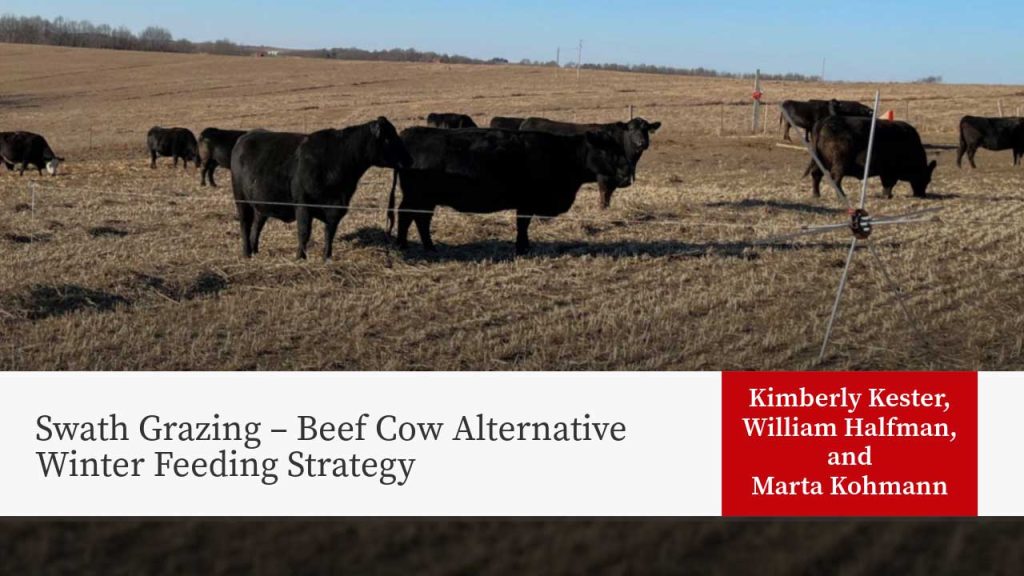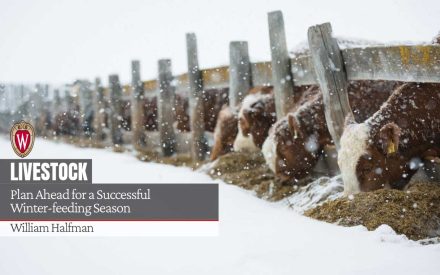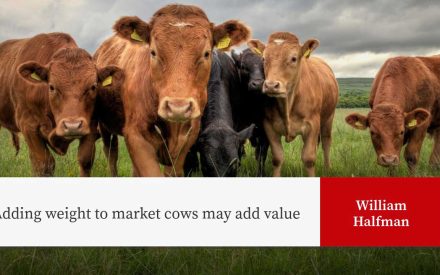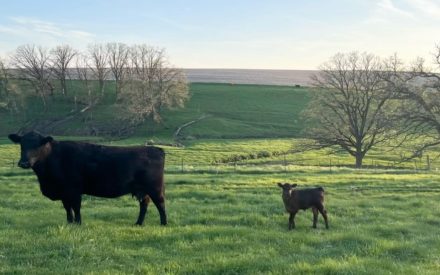
Introduction
Planning for winter feed is an important step in beef cattle operations. Alternatives include stockpiling, corn stalk grazing, and bale grazing. Swath grazing (also known as windrow grazing) has recently gained interest as an additional option. It has potential to reduce time and fuel costs associated with baling, hauling, and feeding out hay. It consists of growing annual grasses, cutting them in late fall, and gathering forage in windrows. Animals, typically dry beef cows due to their lower nutritional requirements, are allowed to graze the forage. This practice is popular in western Canada and some U.S. locations, but is not widespread in the Midwest.
Swath grazing setup
Some Midwest grazing systems use cool- season cereals followed by cool- or warm-season annual grasses to supplement perennial forage pastures. In Canada and Iowa swath grazing evaluations, oats were grazed, followed by no-till planting of millet and sorghum or barley and triticale. In Iowa trials, forage sorghum and pearl millet were planted in early June and cut once for hay in July. Leaving ~8-10″ of stubble, sorghum and millet were allowed to regrow the rest of the season to be used under swath grazing. This two-cut system, where second growth is used for swath grazing, provided higher quality for the swaths. Forages were cut and windrowed late fall to early winter, after the first hard frost and prior to major snowfall. Windrows measured ~2′ across and 9″ deep in Iowa (where they raked two mower passes together), while in Canada swaths were 3′ wide and 18″ deep. In both, swathed forage was left in windrows on the ground. Some farmers merge two mower passes together to keep more of it off the ground, which helps reduce decomposition, makes it easier for cattle to find under snow, and improves utilization compared to smaller windrows. Merging more than two passes may increase waste from cattle laying in the windrows if too much forage is offered at one time.
It is common for cows to be moved to swathed fields after other feed sources are used (e.g., corn residue). Swathed fields should have a perimeter fence with temporary or moveable wire at the “leading edge” running perpendicular to the rows. Initial grazing area should allow for about three days’ worth of herd grazing, with the leading edge wire moving down the rows to expand the grazing area for three more days of grazing as winter progresses. In this strategy, cows can access areas they have already grazed, as the water source is typically located on the starting end of the field. In Iowa trials, cattle numbers were adjusted to field size to provide sufficient swath grazing from late December to mid- February – ~2 head/ac of total field. Each farm is different – a shorter length for the swath grazing season may be a reasonable approach. Using swath grazing for 1-2 months in early winter may be a good fit for some operations and help lower over-winter feeding costs.
Recommended cattle classes
Due to the likelihood of snow cover, swath grazing systems are best suited for bred, non-lactating cows as they are more aggressive grazers and will dig through snow to access swaths. Cows due to calve in mid- to late March would align well with this system. It is important to note, in successful swath grazing conducted in Iowa and Canada, they supplemented the cows beginning three weeks before calving.
Forage nutritive value and utilization
Nutritive value declines with standing forage maturity and over time after swathing. However, results from Iowa and Canada (Table 1) showed swaths from various species retained enough nutrients for dry mid-gestation cows. Swath utilization is equivalent or greater (69-82%) than baled hay (85%) and stockpile (40%) grazing (Dahlke, 2022).
Table 1. Summary of swath grazing studies
| Location and source | Species | Biomass (ton DM/ac) | DM (%) | CP (%) | NEm (Mcal/lb DM) | TDN (%) | Utilization (%) |
|---|---|---|---|---|---|---|---|
| Iowa (Dahlke, 2022) | Sorghum | 1.42 | 38 (reached 80% in Dec. due to dry weather) |
20 to 12 (Oct. to Jan.) | 0.6 to 0.1 (Oct. to Jan.) | NA | 69 |
| Millet | ±1.7 | 24-37 (reached 81% in Dec. due to dry weather) | ±14 (Oct. to Jan.) | 0.5 to 0.3 (Oct. to Jan.) | NA | 72 | |
| Canada, Alberta (Baron et al., 2014; Doce et al., 2015) | Barley (soft dough) | 4.6 | NA | 10.1 | NA | 53 | 72 |
| Corn (milk) | 5.8 | NA | 8.9 | NA | 60 | 75 | |
| Triticale (soft dough) | 7.4 | NA | 7.9 | NA | 58 | 83 |
Challenges
While swath grazing may seem a viable option for winter feeding, there are challenges that must be addressed. A perimeter fence is needed. If using previous hay ground or corn and soybean fields, adding sufficient fencing may be a considerable upfront expense. Since the ground is frozen, many swath grazing operations use “tumblewheels” which do not penetrate the ground like typical temporary fence posts. They roll over top of the ground on six legs held upright by tension of the single leading edge wire, running through the center of the wheel (see photo). Fields must also be accessible for harvesting and windrowing equipment. It may not be an issue out west or in Iowa, but southwestern Wisconsin is known for its hilly landscape with steep slopes. Water needs to be within a reasonable distance throughout the grazing period. If one does not exist, running water to the field may be another expense. There are also risks when operating a mower in cold temperatures. Crop and soil residue can build up in and around cutter heads and discs during normal use. If not cleaned after the last cutting during warm weather, they can freeze and prohibit operation, resulting in costly breakdowns. Planning ahead with the mower is an important consideration. Letting it warm up in a heated shop prior to use is advantageous.
Benefits
Despite challenges, there are also benefits to a swath grazing system when well-executed. There is better forage utilization compared to stockpiling. Since animals are spread out across swathed field and not confined to smaller lots, cows tend to be cleaner, and their new calves have less incidence of scours. It also distributes manure more uniformly across the field compared to bale feeding, which in turn alleviates dead spots from bales and reduces or eliminates field preparation for planting the following crop. Swathed forage never leaves the field and is ready for cattle to consume, thus saving time and money compared to hauling of hay and manure needed in other winter feeding options. Reductions in cost can reach $25-26/ac compared to bale grazing and stockpiling (Dahlke, 2022). Some species (warm season annuals in particular) add drought tolerance to your forage system, a great benefit during hot and dry seasons. Another benefit is adding another crop into the rotation to help reduce disease and pest pressure and maintaining soil cover throughout the year.
Article originally published in Midwest Forage Association’s Forage Focus May 2025.
Authors

Kimberly Kester
Dairy and Livestock Program Manager – Kimberly’s programming focuses on beef cow-calf operations, specifically genetic improvement, heifer development, and heat abatement. She also supports programming in small ruminant parasite management and poultry flock management.

William Halfman
Beef Outreach Specialist – Bill’s educational programming has focused on beef cattle production and management, agronomic crops and soils production and management, small scale fresh market and bedding plant production, and specialty crop management.
References
- Beef Cattle Research Council. (2017). Different approaches/same goal for winter management of heifers. https://www.beefresearch.ca/blog/different-approachessame-goal-for-winter-management-of-heifers
- Baron,V.S., Doce, R.R., Basarab, J., Dick, C. (2014). Swath grazing triticale and corn compared to barley and a traditional winter feeding method in central Alberta. Canadian Journal of Plant Science 94, 1125-1137. doi:10.4141/CJPS2013-412
- Dahlke, G. R. (2022). Swath grazing forage sorghum and pearl millet observations regarding quality and utilization as winter feed. Iowa State University Animal Industry Report, 18(1). doi: 10.31274/air.12602
- Dahlke, G. R. (2023). Winter swath grazing [Presentation]. Field day at ISU McNay Research Farm. https://www.youtube.com/watch?v=onOXEHSpoeg
- Doce, R., Baron, V.S., Dick, A.C. (2015). Estimating swath-grazed carrying capacity from plot-scale data. Canadian Journal of Plant Science 95, 647-651. doi:10.4141/CJPS-2014-353


 Plan Ahead for a Successful Winter-feeding Season
Plan Ahead for a Successful Winter-feeding Season Adding weight to market cows may add value
Adding weight to market cows may add value Thanks for Your Deworming Management
Thanks for Your Deworming Management Choose a Weaning Method to Decrease Stress on Calves
Choose a Weaning Method to Decrease Stress on Calves


